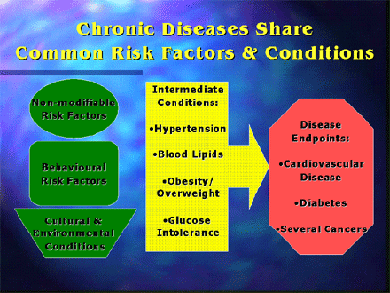Common menu bar links
Institutional links
Diseases & Conditions
Health & Safety
Research & Statistics
Agency Information
Search Box
Centres
E-mail this page
Chronic Disease Risk Factors
What are the Primary Risk Factors?
According to the World Health Report 2002, the major risk factors include:
- tobacco
- alcohol
- blood pressure
- physical inactivity
- cholesterol
- overweight
- unhealthy diet
In individuals, we can classify the risks factors as follows:
- Background risk factors, such as age, sex, level of education and genetic composition;
- Behavioural risk factors, such as smoking, unhealthy diet and physical inactivity; and
- Intermediate risk factors, such as serum cholesterol levels, diabetes, hypertension and obesity/overweight
In Communities, the main factors that can impact health include:
- Social and economic conditions, such as poverty, employment, family composition;
- Environment, such as climate, air pollution;
- Culture, such as practices, norms and values; and
- Urbanization, which influences housing, access to products and services.
The following graph depicts the relationship between risk factors, conditions and common disease end-points:

Chronic diseases share common risk factors and conditions. While some risk factors, such as our age, sex, and our genetic make-up, cannot be changed, many behavioural risk factors can be modified, as well as a number of intermediate biological factors including hypertension, being overweight, hyperlipidemia,and glucose intolerance. Societal, economic, and physical conditions influence and shape behaviour and indirectly affect other biological factors. The recognition of these common risk factors and conditions is the conceptual basis for an integrated approach to chronic disease.
